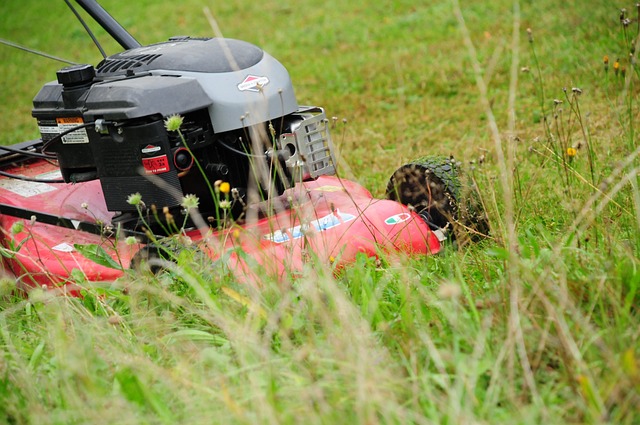Lawn Care and Landscaping are essential for creating a visually appealing and functional outdoor space. A robust lawn care regimen involves selecting grass species suitable for local soil conditions and climate, ensuring optimal growth through tailored practices like aeration and organic matter enrichment. Regular mowing at the correct height for the specific grass type promotes healthy turf. An adaptive irrigation schedule, informed by weather patterns, keeps the lawn adequately hydrated while preventing saturation. Fertilization, thatch and weed management, and vigilant monitoring for seasonal changes or pests and diseases are key to maintaining a resilient lawn. This comprehensive approach not only enhances the aesthetic quality of your property but also supports its functionality, aligning with sustainable landscaping principles. Strategic planning, from design to implementation with native plants and sustainable methods, is crucial for a landscape that is both beautiful and low-maintenance. By integrating pathways, retaining walls, and outdoor lighting, you can create a space that is not only aesthetically pleasing but also practical and easy to navigate. Regular maintenance, including watering, fertilizing, and pruning, ensures the longevity and health of your lawn, adapting with seasonal changes for a flourishing outdoor environment that reflects your personal style and complements your property's unique characteristics.
Embark on a journey through the verdant realm of landscaping design and implementation, where the art of nurturing greenery meets the science of horticulture. This article delves into the intricacies of lawn care and landscaping, providing readers with a comprehensive guide to creating a thriving outdoor space. From the foundations of lawn care that foster a robust turf, to integrating form and function in your design, we’ll navigate the essential steps to transform your vision into a living landscape. Join us as we explore how to effectively plan and plant, ensuring every garden reflects both beauty and practicality. Whether you’re an aspiring green thumb or a seasoned gardener, these insights will enhance your understanding of landscaping design and implementation.
- Foundations of Lawn Care: Fostering a Thriving Turf
- Integrating Form and Function in Landscaping Design
- Implementing Your Vision: From Planning to Planting in Landscaping
Foundations of Lawn Care: Fostering a Thriving Turf

A well-designed landscape with a thriving turf begins with a solid foundation in lawn care. Understanding the specific needs of grass varieties and local soil conditions is paramount for nurturing a lush, resilient lawn. Proper site analysis, including sunlight exposure, water drainage, and soil type, allows for the selection of grass species that are best suited to thrive in those particular environmental circumstances. Effective lawn care practices start with preparing the soil through aeration and amending it with organic matter to enhance its fertility and structure. Regular mowing at the right height for the grass type promotes healthy growth, while an irrigation schedule tailored to weather patterns ensures consistent moisture without over saturation. Additionally, implementing a well-timed fertilization program and controlling thatch and weed growth are critical components of maintaining a healthy lawn. By adhering to these principles, landscaping professionals can create and sustain an environment where turfgrass can reach its full potential, enhancing the aesthetic appeal and functionality of any outdoor space. Regular monitoring and adaptation to changing conditions, such as seasonal weather shifts or the emergence of pests and diseases, are essential for sustained success in lawn care and landscaping. With diligent attention and appropriate interventions, even the most challenging environments can host a healthy, vibrant turf that adds beauty and value to any property.
Integrating Form and Function in Landscaping Design

In the realm of landscaping design, the seamless integration of form and function is paramount to creating an outdoor space that is both aesthetically pleasing and highly functional. Landscaping design goes beyond mere decoration; it involves a strategic approach where every element serves a purpose. For instance, a well-designed lawn not only contributes to the visual appeal but also provides a recreational area for relaxation and play. Incorporating lawn care best practices ensures that the grass remains lush and vibrant, enhancing the overall aesthetic while offering a soft, safe surface underfoot. This balance between form, as seen in the meticulous layout and plant selection, and function, achieved through sustainable practices and practical considerations, leads to an environment that is both beautiful and usable.
A successful landscaping design also takes into account the local climate, soil conditions, and the needs of the plants and trees being used. This thoughtful approach ensures that the landscape not only thrives but also requires less maintenance over time. The use of native plants, for example, is encouraged in many landscaping designs due to their adaptability and lower water requirements. Additionally, incorporating hardscape elements like pathways, retaining walls, and outdoor lighting can enhance both the functionality and visual interest of a landscape. These features contribute to a space that is easy to navigate and maintain while complementing the natural beauty of the surrounding environment. Landscaping design with lawn care at its core thus becomes a dynamic fusion of art and science, creating a harmonious and enduring outdoor living space.
Implementing Your Vision: From Planning to Planting in Landscaping

Embarking on a landscaping project requires careful planning and a clear vision of the desired outcome. The process begins with meticulous design considerations, where the layout of your outdoor spaces is envisioned. This involves selecting appropriate plants for your lawn care and landscaping needs, considering local climate conditions, soil types, and the amount of sunlight your property receives. With these factors in mind, you can choose plant species that will thrive, ensuring a lush and vibrant landscape.
Once the design is finalized, the next phase is to bring your plan to life through implementation. This entails preparing the soil, which may include amending it for optimal nutrient levels. Planting follows, with each specimen placed according to the design plan to create a harmonious and aesthetically pleasing arrangement. Lawn Care and Landscaping practices are integral throughout this process; regular maintenance tasks such as watering, fertilizing, and pruning are essential to maintain the health and beauty of your landscape. Irrigation systems can be installed to optimize water usage and conserve resources, aligning with sustainable landscaping practices. Regular upkeep not only ensures the longevity of your outdoor spaces but also allows for their continued evolution, adapting to seasonal changes and growing conditions. By staying attentive to your lawn care and landscaping needs, you can enjoy a flourishing outdoor environment that reflects your personal style and complements your property’s unique characteristics.
